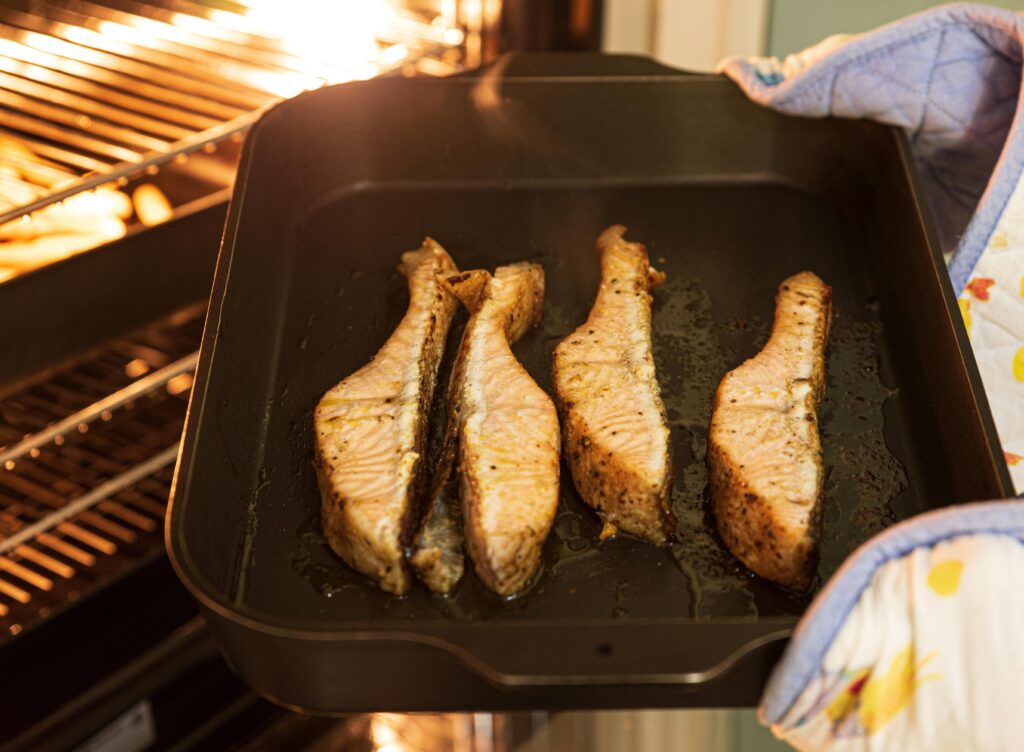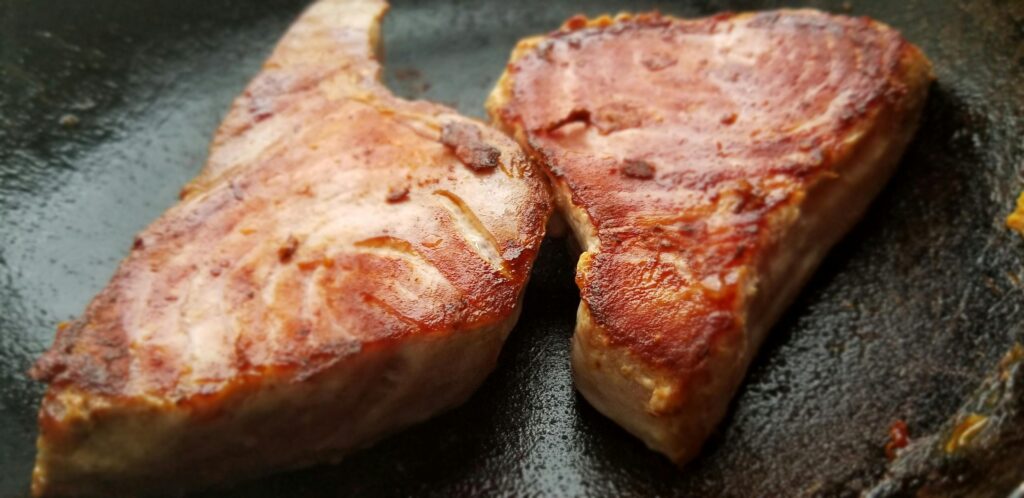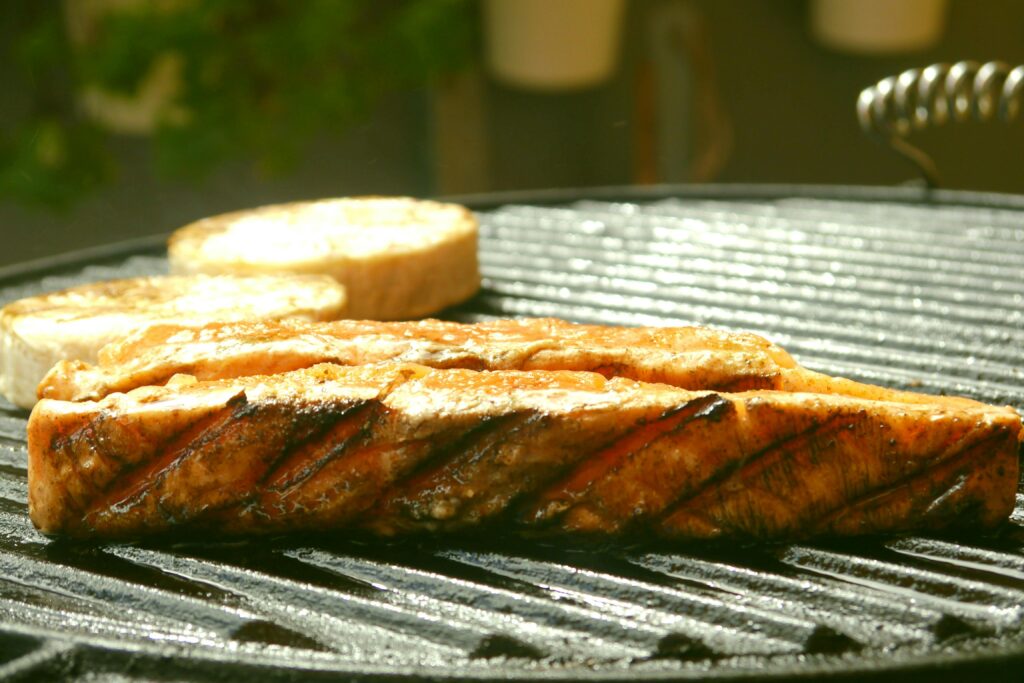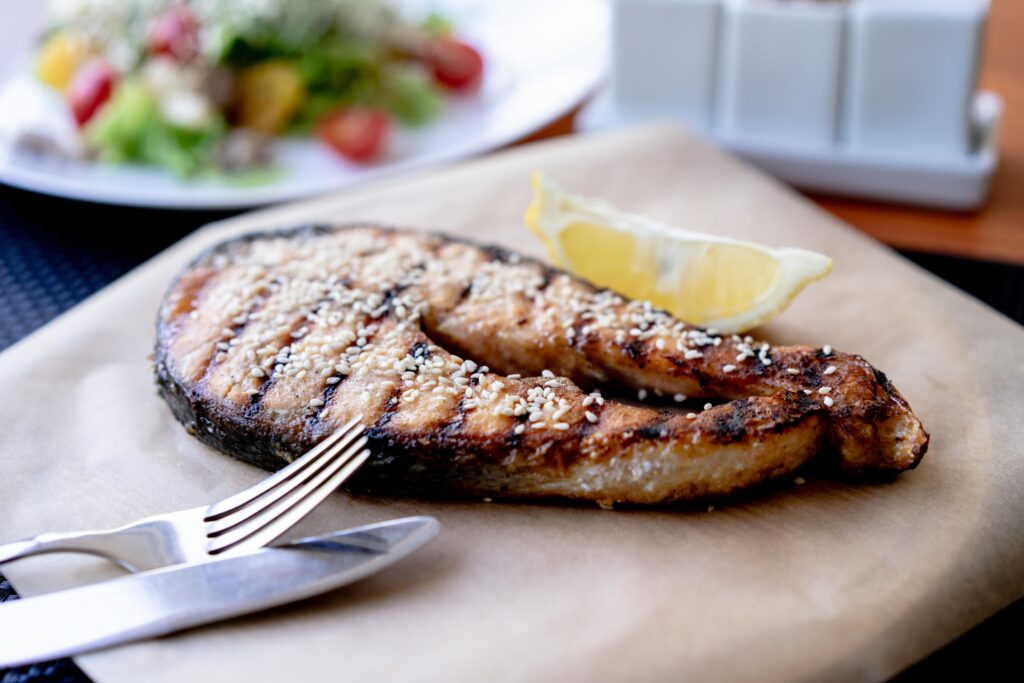So, what exactly is Kama Salmon?
Let’s clear up any mystery right away. “Kama salmon” isn’t some rare or special breed of fish. It’s simply the name for a fantastic, often overlooked part of a regular salmon: the collar. Think of it like the neck and shoulder area, sitting right behind the head and gills. If you’ve ever enjoyed chicken wings, you get the idea – it’s a specific, flavorful cut prized for its texture and taste. Chefs and seafood fans adore kama because it’s packed with rich, moist meat nestled close to the bone. Unlike the leaner fillets you might be used to, kama boasts beautiful marbling – little ribbons of fat running through the meat.

Why Kama Salmon Tastes So Incredibly Good
Magic of kama salmon is really about its magnificent taste and consistency. This cut is inherently full of healthy fats and connective tissues since it lies in such a position on the fish. When you cook it right, something wonderful happens. That fat renders down, keeping the meat unbelievably moist and tender – almost buttery. It literally falls right off the bone with very little effort. The taste? It makes a deeper and more intense salmon flavor than the conventional fillets do. It is savory beyond words, at times it may be even naturally sweet which is simply amazing. As far as texture goes, it is a perfect blend: flakes that are soft but not falling apart against gelatin and melt-in-your-mouth particles that are close to the bone.
Seriously Good for You Too
Eating kama salmon can be a pleasure to your taste buds, but it also can be a superfood that your body will really enjoy. It, like any salmon, is an excellent protein source, high-quality protein, specifically; this high-quality protein is needed to develop and repair muscles, to help you stay strong. The true superstar in this case though is the high level of omega-3 fatty acids particularly EPA and DHA. These are the good fats that are the superheroes of your heart system, as they decrease the inflammation, reduce blood pressure, and make your cholesterol more balanced. And they are vital as well to maintaining the sharpness of your brain and the level of your mood. Kama salmon is another great source of Vitamin D, which most of us lack, and that makes bones strong and our immunity strong.
Cooking Kama Salmon at Home is Easier Than You Think
Do not get scared! Making kama salmon is easy and gives impressive results, which would almost pass as restaurant quality. The classical technique is by grilling or broiling and brings out the flavors really well. First put the salmon collar to a dry paper towel with a pat to make it crispy. and season it with a good deal of salt and pepper; that generally suffices. Additional flavor is done by marinating soy sauce, a little mirin (sweet rice wine), some fresh ginger, and fresh garlic; that enhances the flavor greatly. Make your broiler or grill really hot. Put the collar, skin side down. It should be roughly 5 to 7 minutes each side depending on the thickness of your piece.

A Flavor Adventure Around the World
The deep, delicious salmon collar is what makes this part of fish so popular in kitchens worldwide with no problem getting it to fit any combination of exhilarating flavors. Known in Japan as sake kama, all you can get is usually grilled with simple salt (shioyaki), glazed with sweet and savory teriyaki sauce or good old miso paste. It is usually garnished with a small mound of grated daikon radish that provides a crisp fresh flavor which balances out the richness just right. It may be cooked by Korean cooks marinated in spicy, fermented gochujang paste before grilling. In Hawaiian poke bowls, you could even come across some marinated, raw salmon collar that gives an added texture to the food. Over in the Mediterranean, it gets a treatment of good olive oil, bright lemon, pungent garlic, and fresh herbs like dill or oregano.
Finding Fantastic Kama Salmon and Keeping it Fresh
A high-quality piece should be taken as a matter of principle to make a really good kama salmon. When in a fish snackbar, search in collars in which the flesh appears fleshcolored and juicy. It may be deep pink to rich orange-red depending on the specimen of the salmon( King, Sockeye and Coho among others). Avoid those that appear dry, faded, or have rusted edges, that is an indication that it has exceeded its shelf life. Take a delicate whiff at it. It should be clean and fresh like the wind in the sea, no heavy and offensive smell of fish or smell of ammonia.
Serving Up Your Delicious Kama Salmon Masterpiece
Part of the fun of kama salmon is presenting and enjoying it. It is a hands-on bone-in cut it is usually served as a whole piece on the plate. Cooking it with the skin-up allows everyone to appreciate that fancy, hellish skin that you tried so hard to do. To be thoroughly Japanese, accompany it with a slice of fresh lemon, a wee handful of that wave-cooling daikon radish, grated, and, perhaps, a small bowl of the tangy ponzu sauce (a lemon-soy combination). The image is crowned magnifiedly with a side of plain steamed rice as well as a hearty bowl of miso soup. Green vegetables made nice accompaniments, like broccoli, asparagus or bok choy to give a bit of color and to balance the health issues.

Enjoying Kama Salmon is Actually a Smart Choice for the Planet
Here’s a feel-good bonus: choosing kama salmon can be a really eco-friendly move. Using the collar is a prime example of “nose-to-tail” eating, but for seafood. Previously, when salmon were filleted to those familiar portions, the collars usually ended up in the garbage, or rendered into low-value products, such as fishmeal. In enjoying kama salmon when you seek it out, you are contributing to saving wastage and putting far better use of the whole fish. This promotes sustainable fishing as people eat more of each salmon of value caught. Naturally, the whole effect is still concentrated on the sourcing and production spots. Look out for reliable labels such as the Marine Stewardship Council (MSC) certificate on wild-caught salmon or the Aquaculture Stewardship Council (ASC) certificate on responsibly farmed salmon.
Kama Salmon vs. Regular Salmon Fillets
| Feature | Kama Salmon (Collar) | Regular Salmon Fillets | Why You’ll Love Kama |
| Cut Location | Neck & collar (behind head/gills) | Mid-body (boneless/skin-on strips) | Hidden gem – maximizes flavor from underused part of fish. |
| Texture | Ultra-juicy, buttery, falls off the bone | Flaky, tender (can dry out if overcooked) | Melts in your mouth – rich fat keeps it incredibly moist. |
| Flavor | Richer, deeper salmon taste; savory-sweet notes | Mild, clean salmon flavor | Bolder taste – like the “dark meat” of salmon. |
| Cooking | Hard to overcook (bone-in protects meat);Crispy skin + caramelized edges | Needs careful timing;Even sear/roast | Forgiving & fast – grill/broil in 10-12 mins. Perfect for weeknights! |
| Price | Often more affordable (less demand) | Typically higher cost per pound | Budget-friendly luxury – restaurant quality at home. |
| Sustainability | Reduces waste (uses “discarded” part of fish) | Standard cut (high demand) | Eco-smart choice – supports nose-to-tail seafood eating. |

Bring Restaurant Magic to Your Dinner Table with Kama Salmon
Kama salmon is an outstanding opportunity to get a completely unique, restaurant style seafood experience straight in your own home, and do so without having to call on exquisite talents, or drain your bank account. It is naturally rich and the bone-in architecture makes it highly tolerant of home cooks, both novice and experienced. The reward: you get rich satisfying flavor, a great presentation that will make it appear that you fussed (when you did not!), and also the best nutrition in a single simple package. Not only can you learn what makes kama so special, but just testing a couple of easy-going cooking methods, trying different world-wide flavors and picking your salmon smartly, you can definitely turn this chef secret into a nightly success on your family’s table.
FAQs
1. What part of the salmon is “Kama”?
It’s the collar! That is the tasty, fatty part right behind the head and gills, as the neck and shoulder of the fish. It is salmon wings so-to-speak.
2. Why does Kama Salmon taste so good?
It contains a lot of rich, healthy fats and juicy meat near the bone. Baked it becomes just unbelievably tender (it is approaching butter consistency, no steak needed, at all!), pulls off the bone and tastes much more deeply and richly salmon-like than the usual fillets, and its skin becomes the prettiest, crispiest brown.
3. What’s the easiest way to cook Kama Salmon at home?
Grilling or Broiling is very simple! Blot off the surface moisture; and then sprinkle generously (salt and pepper or a quick soy-ginger marinade); then on high heat, sear the flesh side down first about 5 or 7 minutes on each side. It is bound to be moist and un-overcooked by the bone.
4. Where can I find Kama Salmon?
Ask your fishmonger! Look at fresh fish counters or Asian markets. To look fresh in color (pink/orange-red), wet flesh, and ocean-fresh fragrance, dry, or potent odor should be avoided. Frozen products (with nice packs) are also effective.
5. Is eating Kama Salmon actually a sustainable choice?
It can be yes! The selection of the collar will minimize the waste as more of the fish is utilized (nose-to-tail eating). This makes better use of each salmon caught. For the best impact, look for MSC (wild) or ASC (farmed) certified salmon too.
